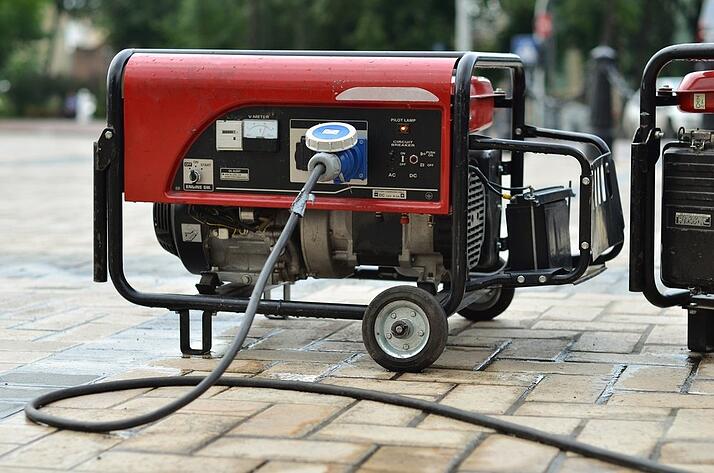Call 1300 799 969 | Contact Us


Home » The Best Ways to Reduce Generator Noise
Trying to reduce generator noise is quite often one of the most significant issues on a construction site.
It can be a challenging problem to overcome, especially when compounded by other industrial noises such as jackhammers, concrete cutters, and so forth. (Ironically at times operated by that very same generator.)
If you have a noise problem with an existing generator, or you are planning for a generator coming on-site, it will pay you to speak to Australia’s industrial noise control specialists.
The dilemma for environmental managers is to satisfy the site’s need for power, and yet balance it with acceptable levels of noise under environmental noise requirements.
Before buying or hiring a generator, it is imperative to read the manufacturer’s specifications to determine how noisy it will be operating at full load.
When doing this, it is vital to bear in mind that the generator set may appear quieter on paper than it does on-site, as the specifications may not tell you the full story.
The characteristics of the site can also influence the final generated noise.
For example, some manufacturers may give you the figures for mechanical noise, but fail to include the additional problem of the exhaust noise.
Manufacturers figures can result in a situation where the specs say your noise levels are within EPA guidelines, but in reality, you aren’t.
The exhaust noise must be taken into account, primarily if the sound pressure level calculations (dB) were poorly derived.
When comparing generator sets, it’s essential to consider the actual mechanical noise and the exhaust noise.
You also need to take into account that it isn’t just the sound pressure that affects loudness, but also the frequency of sound.
The frequency affects the perceived noise level and also increases the difficulty level in treating it.
The other consideration is that mathematics isn’t straight forward when there are multiple pieces of equipment operating.
For example, two gen sets each operating at 100 dB do not produce twice the decibel level, but instead, increase the total sound level by around 3 dB.
In an ideal world, you would house the generator in a double-walled acoustic enclosure, with full sound absorption and state-of-the-art vibration isolators.
By doing so, you could reduce noise by between 60 and 80 dB, but that would be far from ideal on a construction site.
It would be impractical to encase the gen set in a static acoustic enclosure or lock it in a soundproof room.
For starters, generators have to breathe, and their performance would be affected by the higher operating temperatures.
On top of that, there are also all the servicing issues, such as refuelling and maintenance.
Furthermore, there are space restrictions on a construction site, and the acoustic enclosure would need to be considerably more significant than the generator itself.
The preferred option would be to set the generator up in a fixed acoustic enclosure and leave, but that is often just not possible.
As an Environmental Manager, you face several challenges.
There’s pressure to keep the gen-set quieter, but you also have to work around the reality of day-to-day life on a busy, fast-moving building site.
If there’s a delay in construction, no one is going to say: “Yes, but isn’t it quieter.”
Therefore, you require a mobile noise barrier that is easy to set up, take down and move to the next section of your site.
In some cases, Temporary Noise Barriers (also called Noise Curtains, Sonic Curtains, Noise Blankets, Sound Barriers, Noise Reduction Curtains and numerous other names) have been placed around a generator on wheels, to offer a trailer-mounted solution.
A trailer-mounted solution combines the benefits of both fixed AND mobile options and is an excellent solution.
Flexshield’s Temporary Noise Curtains have a standard height of two (2) metres. They are hung from temporary fencing, so to accommodate for the acoustic shadow.
For example, you may have to bypass the fencing and opt for scaffolding instead to increase the height.
Such was the case involving a demolition project for Lend Lease, in which we custom made a massive 12-metre noise barrier – six sonic curtains on top of each other – right around the site and successfully solved their pressing industrial noise problem. Read all about the project here.)
Similarly, if the noise output is particularly high, and the generator soundproofing on all four sides is not sufficient, you may need to position a noise blanket over the top. (Although this will create servicing problems similar to using a fixed acoustic enclosure.)
You can, however, do not think that by using two noise reduction curtains, you’re going to achieve double the noise reduction.
It doesn’t work like that.
Let’s say that one sound barrier reduces generator noise by 18 dB you won’t minimise generator noise by 36 dB by using two.
At best, you might achieve an extra 3 – 5 dB noise reduction.
In short, there are quite a few ways to reduce generator noise on a construction site, and it’s the case of what works best in terms of both soundproofing and productivity is the right way.